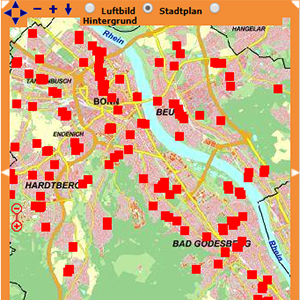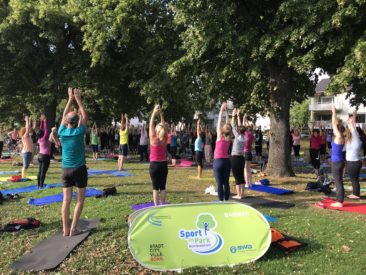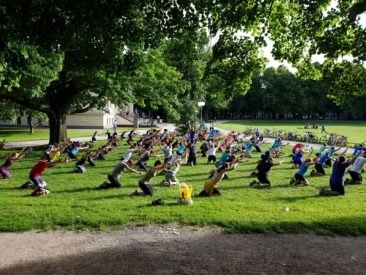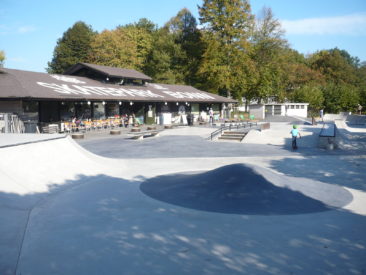BONN – map of sport facilities
1. General scope of the Pilot Action
The understanding and behavioural patterns of physical activity and sport has significantly changed in the past decades. In order to address the changed demands of public space and sports facilities the city of Bonn initiated an evaluation and planning process developing an “sports development plan” (SDP). This process focusses on the given sport infrastructure, its current state and the needs for the next 15 Years. Since sport in germany is traditionally organized through sports clubs and the sport facilities are mainly designed for clubsports, HEPNESS brings a wider understanding of sport and physical activities and informal sport in public space to that SDP.
The administration has done a representative scientific survey, sending extensive questionnaires to 5000 households, to key actors and all sports clubs. In addition, there has been an online survey on the municipal participation platform, asking about needs and capacities of public sports facilities and potential public spaces in order to empower and enable people to be active. Identified public space for activities will be mapped and added to the online registry map of sport facilities.
2. Specfic goals and tasks to be fulfilled
The specific goals of HEPNESS activities are following three main tasks: First to do a thorough needs and capacities assessment for sports and physical activities and the respected infrastructure, second to develop strategic goals based on the results and third to promote and develop public space for physical activity.
The first task was the thorough assessment of the physical activities and the expectations of citizens on public space and sports infrastructure and a thorough assessment of sports facilities and public space in order to have a solid information base for future planning. Based on the assessment strategic goals for sport and physical activities were developed and will be approved by council. In those goals the HEPNESS perspective has added new concepts of understanding and integration of physical activity in city planning and municipal duties. The informal sport and physical activities and the concept of sport in public space, for example, are now complementing the formal sports and sports club infrastructure in the strategic development perspective. Further has the concept and understanding of sport planning transformed into a larger and more integrated aspect of the overall city planning.
An external expert has been assigned in order to do the assessment and the sports development plan. The City Administration has assigned three employees in order to coordinate and support the two years process and ensure that the HEPNESS perspective will be integrated in the process. A taskforce has been installed including representatives of the following departments and organisations gathered depending on the topic:
Facility management, school department, facility managements, school department, department for citizen participation, fundraising/project department, department city planning, head of sports and culture, department for children, youth and family, scientific consultancy for sport (private), head of city sports association (civil society), department for green infrastructure, head of department for sports and department of social affaires and housing. This taskforce has met 5 Times in order to discuss, prepare and coordinate the development of the strategic goals and the future action plan.
The second task was and will be to promote and develop public space for physical activities. As first physical activities in public space the city promoted “sport im park” a program implemented throughout the entire summer offering several trainings in parks on every day of the week, in several parts of the city, open for everybody and free of charge. Another activity is the “Spielmobil”, a truck equipped with all kinds of toys and sports equipment to motivate children and youth to be physically active and enjoy public space. The “Spielmobil” sets up shop at afternoons and on weekends in different parts of town circulating frequently. The existing pedestrian and cycling paths are continuously improved and marked in order to give bicycles priority in more and more streets and in order improve the connections of the bicycle lane network to promote and facilitate cycling paths as an attractive alternative to other transportation and a way to be active.
The most resent and also most important redesign of public space is the new skate park. The skatepark hast been erected on the areal of a former traffic education school. The space was out of use and a closed area. The skate park is now open for everybody and run and maintained by a local skate club.
The development and redesign of a sports field and small park in the inner city is one of the biggest projects in process in city planning related to public space in the city of Bonn. The “Reuterpark” will be completely redesigned into a “place for all”. The concept has been developed by citizen initiatives in open workshops and in cooperation with a landscape architect. The aim is to offer space and facilities for a great variety of physical activities and offer space for social interaction and relaxation in an inclusive way.
The third task of the HEPNESS activities is mapping sports facilities and public space for physical activities and sport. Therefore, public spaces have been and will be identified and their data sets have collected. This data was and will be integrated in the existing data about the green infrastructure and sport facilities in order to be able to show an as complete as possible picture of the sport infrastructure and opportunities to be active as possible. Based on this information a website has been set up to complement the existing geo data system showing public space for physical activity.
3. Target groups aimed by the activities
The main target group are all people living or staying in Bonn. The aim is to increase visibility and promote and enable activities in public space and improve the necessary infrastructure. The target groups related to planning and implementation are all affected and relevant internal and external stakeholders in the process of Bonn as an active and healthy city.
4. Methodology and tools
The survey and assessment has been done in a transparent process, approved by city council. The consultant is a professor of sports science and followed a scientific participatory approach, that includes citizens and local key actors in sport and physical activity. 5.000 questionnaires have been sent to private Households, 1.278 filled and send back. 97 Clubs filled questionnaires representing 51.000 members and an online survey on Bonn’s participation platform received almost 500 feedbacks, comments, and answers.
The installed HEPNESS task force considered the results of the survey and shaped the sports development plan and strategic goals due to their fields of responsibility and competence.
The entire cooperative process led to a final report and the strategic goals acknowledged by council organs and will be approved by council in its final version in 2019.
5. Expected impacts and benefits from the pilot actions
The expected impact are the acknowledgment of a wider and connected understanding of sport and physical activity, an improved cross sector cooperation within the internal and external stakeholders in physical activity related processes, an concrete action plan promoting sport and physical activity in public space and improving the relevant infrastructure and integrate social and health benefits into the planning processes.




